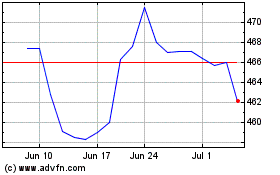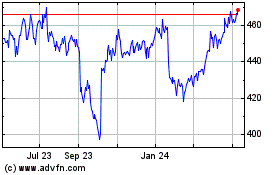By Paul Sonne
The makers of precision-guided missiles and bombs are running to
keep up with demand as the U.S. military bombards Islamic State
from the air.
Companies such as Boeing Co., Lockheed Martin Corp. and BAE
Systems PLC -- which make the precision-guidance kits that carry
U.S. missiles and bombs to their targets -- are benefiting from the
U.S. military's increased reliance on air power in the Middle
East.
Nowhere is the U.S. emphasis on air power more pronounced than
in the campaign against Islamic State. As of mid-December, the U.S.
had conducted 13,041 airstrikes against Islamic State in Iraq and
Syria over about 28 months, according to U.S. Central Command, with
a single strike often carrying more than one munition. Coalition
allies carried out an additional 3,747 strikes over the same
period.
"Right now, we're more kinetic than we've ever been in this
campaign," U.S. Air Force Chief of Staff Gen. David Goldfein said
in an interview late last year. "We're hitting more targets than
we've ever hit in a long time in Iraq, Syria and in Afghanistan, so
when that goes up, that means more munitions are required."
The extremely accurate munitions don't come cheap. Equipped with
sophisticated laser or GPS targeting technology, a single bomb or
missile can cost from $30,000 to $115,000. Overall, the U.S. Air
Force has expended about $2 billion worth of precision-guided
munitions on Islamic State since the start of the campaign in
August 2014, dropping more than 40,000, according to Air Force
officials. U.S. aircraft have dropped nearly 18 times more weapons
on Islamic State than on targets in Afghanistan over the same
period.
Gen. Goldfein says that for U.S. pilots, extreme accuracy is the
difference "between hero and zero" and a matter of American values.
"You either get it exactly right, or you get it exactly wrong," he
said. "In the business of modern warfare, the expectation is
precision on every strike. So through that lens, the cost factor is
less of an issue."
The accuracy helps the military avoid killing civilians. Still,
the Pentagon said Jan. 2 that coalition airstrikes had
unintentionally killed at least 188 civilians during the campaign.
Groups that track the strikes primarily using open-source reports,
such as Airwars, put the number far higher.
Airstrikes have become central to the Islamic State campaign in
part because of the rise of U.S. drone capabilities and an
increased imperative in Washington to reduce American military
casualties.
The air-centric nature of the fight has strained U.S. supplies
of the three preferred precision-guided munitions: Lockheed
Martin's hellfire missile, and Boeing's small-diameter bomb and
joint direct attack munition, or JDAM.
As a result, Gen. Goldfein says he is shifting supplies to the
Middle East from Europe and the Pacific to keep campaign commanders
armed with what they need, and then backfilling the arsenal in
Europe and the Pacific when new munitions arrive.
"It's a daily management issue," Gen. Goldfein said. "It's not a
crisis by any means, but it is a concern, because any given day,
you do have some risk that other combatant commands are carrying
until you replenish their stocks."
Looking to invest in other areas, the U.S. military didn't
devote large swaths of the defense budget to stockpiling
precision-guided munitions following the withdrawal from Iraq. But
after Islamic State swept the country in 2014, the U.S. was forced
back into a full-scale air war -- and needed to shore up its
arsenal.
Since then, lawmakers have allocated more funding for
precision-guided munitions, and the White House shortened the time
it takes to replenish expended munitions -- previously as long as
four years.
Suppliers, meanwhile, are ramping up production.
Boeing is producing about 120 GPS guidance kits for the JDAM
each day at its plant outside St. Louis, Mo., up from about 40 in
early 2015, according to Greg Coffey, the company's JDAM programs
director. He expects production to reach 150 a day by next July, or
about 36,500 a year.
The ramp-up will take Boeing's JDAM production rates to a high
not seen since the early days of the Iraq War, according to the
company.
"I see demand for the weapon in significant quantities for the
next decade," Mr. Coffey said.
The Air Force has dropped JDAMs on Islamic State targets more
than any other precision-guided munition in the past year. The JDAM
kits transform a 2,000- or 500-pound "dumb bomb" into a
hyperprecise weapon that pinpoints its target using either GPS or
laser technology. In the year ended Sept. 30, the Air Force dropped
14,764 of them, according to Air Force officials.
Boeing also is preparing to boost production of small-diameter
bombs to five times the current production rate by the end of 2017,
Mr. Coffey said.
Lockheed Martin increased deliveries of hellfire missiles for
its contract with the U.S. Army. In the third quarter of 2016,
Lockheed reported a $45 million jump in net sales of tactical
missiles compared with the prior year, attributing the increase
mainly to hellfire deliveries.
Officials also are adding other munitions. The Air Force
introduced a new precision-guided rocket to the fight against
Islamic State in April. Known as the advanced precision kill weapon
system, or APKWS, it consists of a round of seven hydra rockets
manufactured by General Dynamics, harnessed with laser-guidance
kits made by BAE Systems.
BAE is increasing production of the laser-guidance kits at its
plants in New Hampshire and Texas, preparing to manufacture 10,000
a year by the end of 2017 and 20,000 a year by the end of 2018,
according to the company.
Write to Paul Sonne at paul.sonne@wsj.com
(END) Dow Jones Newswires
January 05, 2017 05:44 ET (10:44 GMT)
Copyright (c) 2017 Dow Jones & Company, Inc.
Lockheed Martin (NYSE:LMT)
Historical Stock Chart
From Mar 2024 to Apr 2024

Lockheed Martin (NYSE:LMT)
Historical Stock Chart
From Apr 2023 to Apr 2024
